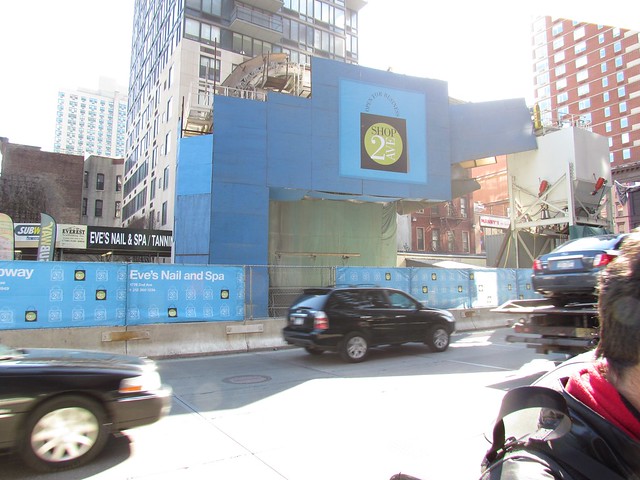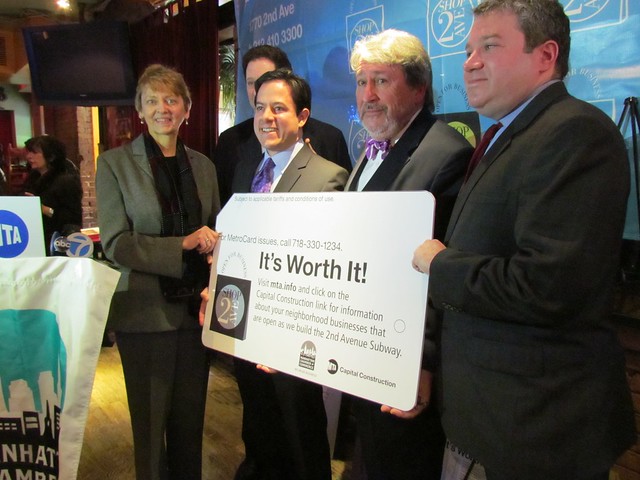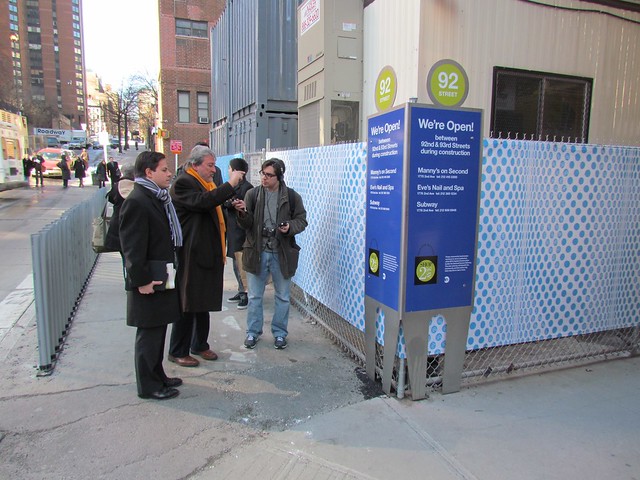
The new look for the SAS construction site tries to promote businesses along the avenue. (Photo by Benjamin Kabak)
When Adi, the tunnel boring machine hard at work beneath Second Ave., reached the end of its western end, the MTA rightly celebrated. For a project that’s been decades in the making, the end of a TBM run is cause for celebration indeed. It’s easy, though, to lose sight of the fact that the subway won’t be ready for revenue service until at least December of 2016.
The merchants and residents of Second Ave. haven’t forgotten. For years, they’ve raised a cry about the state of their avenue. From 96th on down, the bustling commercial strip has been marred by construction work, debris and a state of disarray. Crosswalks are haphazardly constructed and blocked off while dirt piles up and sidewalks trimmed to just seven feet. Nothing about it is all that welcoming for residents, shoppers or business owners, and merchants, in particular, have been asking for change for years.
At the end of last week, the MTA, the Manhattan Chamber of Commerce and various elected officials gathered on the Upper East Side to celebrate the beginning of that change. The authority announced plans back in October to beautify the construction site, and this week, they unveiled the model block between East 92nd and East 93rd Streets with more changes to come throughout the construction zone over the next few months. “We tried ask the question, ‘What can we do considering we’re going to be here for a long, long time?'” MTA Capital Construction President Michael Horodniceanu said during the press event.

MTA officials and area politicians highlight the MetroCard urging shoppers to head to Second Avenue. (Photo by Benjamin Kabak)
Flanked by Jeffrey Bernstein, chair of the MCC, Dan Garodnick, City Council member, and Jonathan Bing of the State Assembly, Horodniceanu walked through the various upgrades. For those living in the area, the most obvious improvements are physical ones. The crosswalks will have barriers to protect pedestrians; the construction sites will be wrapped more orderly; the sidewalks will be expanded to nine feet in some areas. For merchants, each street corner will feature a wayfinding sign with information about open businesses, and the construction site will broadcast those businesses that are behind the netting as well. It’s all about improving the quality of life.
“The goal of this renewed marketing strategy and the model block is to allow New Yorkers to look past the construction and see the vibrant businesses that are here,” said Council Member Dan Garodnick. “This area has been neglected for too long, so we welcome the MTA’s commitment to work with the merchants and the Manhattan Chamber of Commerce to make the entire corridor more presentable and help us send the message that Second Avenue will always be open for business.”
Beyond the construction site itself, the MTA is helping to promote shopping along the avenue. It will distribute two million MetroCards in vending machines along the Lexington Ave. IRT with a message about supporting local businesses on the back, and it is working to revamp the Shop Second Ave. website. The new slogan — “Shop Second Avenue…It’s Worth It!” — is a work in progress.

New signs at every corner will highlight businesses open on blocks obscured by construction. (Photo by Benjamin Kabak)
Of course, it’s a positive that politicians and the MTA have finally been able to come together to help merchants. As Bing noted, he has tried to win grants and tax breaks for Second Ave. businesses but had been met with resistance from both the State Senate and former Gov. David Paterson. Stil, I have to wonder what took the MTA so long to get these improvements off the ground.
During the press conference, Horodniceanu addressed that question. “We were really not doing enough,” he said. “Our contracts are not geared toward this length of time.” So to solve these problems, he, his staff and the MTA contractors tried to figure out “what small things we can do to make a difference.”
For now, as construction moves ever onward, politicians will continue to pressure the MTA to improve the work site. “We have six more years of construction,” Garodnick noted. “It’s a safe bet business owners will encounter new challenges.”
As the representatives and business owners look forward to the day when Second Ave. has both Select Bus Service and a subway, they know it will, in the words of Assemblyman Bing, have “the best transit options in the city.” The construction will disappear; the shoppers will return; and everyone will prosper. But that day is a long way away, and for now, minor changes are much appreciated. “It’s brining order out of chaos,” Garodnick said while standing across the street from the launch box. “It’s an improvement.”
Click through for more photos from the model block and press conference.

10 comments
“the day when Second Ave. has both Select Bus Service and a subway”? I thought that once the (entire 4-phase) subway was complete, that SBS would go away on Second Ave. SBS is an attempt to make bus service a little more “subway-like”. To have both would be kind of redundant, wouldn’t it?
As far as I know, there are no plans to eliminate better bus service once three stops of a subway line open on Second Ave. That’s self-defeating.
They need to institute better bus service before they can eliminate it.
It’s kind of ridiculous they didn’t do this from the beginning.
This is a point I didn’t stress enough in the post. There’s absolutely no excuse for the three-year gap in between the start of construction and the beginning of these street beautifying efforts.
Ben,
when the Portland transit mall was reconstructed for lightrail, a lot of atention was put on business permotion & retention in the construction zone. As a result only a handful of businesses ended up closing. That’s remarkable when you consitter that construction lasted for 2-years. As of now from what what I was able to gather, things have improved quite a lot includind traffic/ padestrian movement, safty & business activity.
If it can happen there, why not here?
Building light rail is far less arduous than rapid transit buried underneath a street, so of course not as many stores closed.
I was working in Downtown Houston when the light rail system was being built, and they used it as an opportunity to rebuilt the street from building line to building line, including a massive utility relocation project and combined sewer separation project.
I would guess that disruption levels were similar to what Second Avenue is seeing, if not for as long of a time period.
Sean, when was that? Given the economy over the past few years, a number of business may have struggled/closed even if not for the subway construction. Not saying that the construction didn’t hurt — it absolutely did — but we really can’t tell how much.
It’s not worth it!